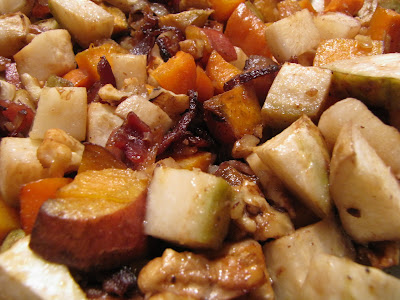 This dish was inspired by the bacon Brussels sprouts I made for Thanksgiving. This was much easier though, and I liked it a little better. The Brussels sprouts were almost too rich - this ended up hearty, but not too intensely bacon-y. Thanksgiving it supposed to be about decadent food though, so I'm certainly not criticizing the sprouts!
This dish was inspired by the bacon Brussels sprouts I made for Thanksgiving. This was much easier though, and I liked it a little better. The Brussels sprouts were almost too rich - this ended up hearty, but not too intensely bacon-y. Thanksgiving it supposed to be about decadent food though, so I'm certainly not criticizing the sprouts! I started out by frying up four slices of local organic uncured bacon. I usually cook bacon too hot and burn it, but I did well this time. It ended up crispy, but not burnt.
I started out by frying up four slices of local organic uncured bacon. I usually cook bacon too hot and burn it, but I did well this time. It ended up crispy, but not burnt. I pulled a bunch of local root vegetables out of the fridge, but I ended up not using the rutabaga and one of the carrots. I was cooking for just myself, so there was no point in making WAY too much. I still have plenty of leftovers with the veggies I did use.
I pulled a bunch of local root vegetables out of the fridge, but I ended up not using the rutabaga and one of the carrots. I was cooking for just myself, so there was no point in making WAY too much. I still have plenty of leftovers with the veggies I did use. I chopped the veggies into small cubes - it ended up being mostly celariac and yam.....then put them in a pie plate and mixed them with the crumbled bacon and some walnuts. I added a bit of (local) maple syrup to the pan with the bacon grease, let it dissolve, and then poured the mixture over the veggies and mixed it all up well.
I chopped the veggies into small cubes - it ended up being mostly celariac and yam.....then put them in a pie plate and mixed them with the crumbled bacon and some walnuts. I added a bit of (local) maple syrup to the pan with the bacon grease, let it dissolve, and then poured the mixture over the veggies and mixed it all up well. It roasted in a hot oven for about a half hour or 40 minutes. It was really really good! The maple syrup was subtle, but added the perfect sweet touch to the bacon's saltiness.
It roasted in a hot oven for about a half hour or 40 minutes. It was really really good! The maple syrup was subtle, but added the perfect sweet touch to the bacon's saltiness. I crumbled a bit of local blue cheese on top in my bowl. Superb!
I crumbled a bit of local blue cheese on top in my bowl. Superb!Maple Bacon Roasted Roots
Root Vegetables - As many as you want. Any roots will work.
Bacon - About 1 slice per cup of vegetables.
Chopped Walnuts
Maple Syrup - To taste. I used about 1 tablespoon for 1.5 cups vegetables
Blue Cheese
Preheat oven to 425 degrees. Fry bacon until crispy. Set it aside and let it drain on a paper towel. Meanwhile, cut up roots into whatever size chunks you like. Put vegetables into a baking pan. Crumble bacon and add to roots, along with walnuts. Mix maple syrup in hot pan with bacon grease. Pour liquid over vegetables and mix well to coat. Roast until vegetables are tender, probably about 30 to 40 minutes. Take out of the oven and stir occasionally during cooking to make sure vegetables don't stick.
Root Vegetables - As many as you want. Any roots will work.
Bacon - About 1 slice per cup of vegetables.
Chopped Walnuts
Maple Syrup - To taste. I used about 1 tablespoon for 1.5 cups vegetables
Blue Cheese
Preheat oven to 425 degrees. Fry bacon until crispy. Set it aside and let it drain on a paper towel. Meanwhile, cut up roots into whatever size chunks you like. Put vegetables into a baking pan. Crumble bacon and add to roots, along with walnuts. Mix maple syrup in hot pan with bacon grease. Pour liquid over vegetables and mix well to coat. Roast until vegetables are tender, probably about 30 to 40 minutes. Take out of the oven and stir occasionally during cooking to make sure vegetables don't stick.
share on: Facebook




























































